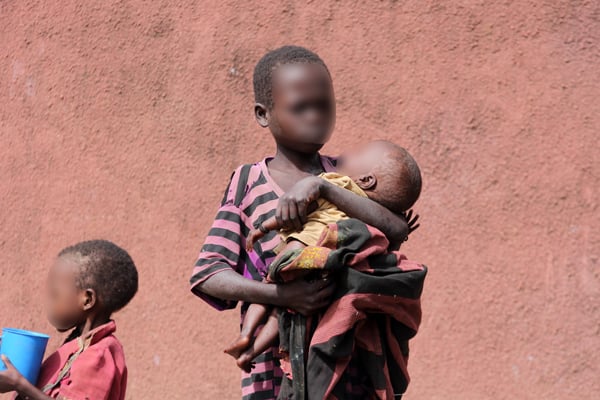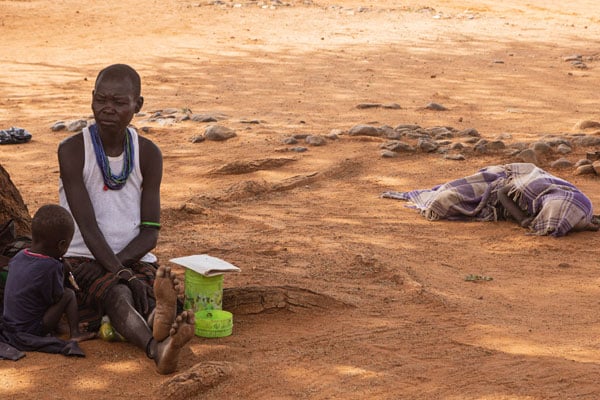Prime
More than 20,000 children in Karamoja are malnourished

Children get few essential nutrients. PHOTO | ANDREW KAGGWA
What you need to know:
- The prevalence of global acute malnutrition among children in the nine Karamoja districts is at 13.1 percent with Moroto and Kaabong being the most affected. Concerned parties emphasise the need for a mindset change before any change is realised.
While travelling to Lorikowa Village, Nadunget, in Moroto District, you cannot fail to notice the clear blue skies. From a distance, community leaders sing, clap and dance seemingly making merry.
But this is not the case. Instead, they are singing to welcome visitors they hope have come with a rescue plan. Many are mothers who have lost children to malnutrition-related illnesses and those taking care of children who have just been discharged from hospital due to malnutrition. What many of these women have in common is being the breadwinners in their homes.
Veronica Lokiru, one of the mothers, says much as things have never been that good, of late, the situation has deteriorated. Previously, many of their husbands owned herds of cattle but with the increase in cattle rustling, they lost their herds. Sadly, they did not adjust to find new ways of livelihood.
Like in the past, most husbands still wake up to go to the fields, this time though, not to necessarily take care of cattle but to sit with other men and watch the day go by. The women run their homes by doing as many odd jobs as they can to raise money for food.
“When I make money, they eat but if it is a bad day, we sleep angry,” Lokiru says.
Not an isolated case
Women such as Lokiru keep scrapping for a measly Shs2,000 or Shs3,000 a day to feed their families. But she only earns that money when she fetches several jerrycans of water at a cost of Shs200 per jerrycan. To earn the targeted Shs2,000, she has to fetch at least 10 jerrycans. Most mothers thus recruit their older children to work with them.
Lokiru, a mother of three for instance, will go to Moroto Town with her older child and leave the younger daughter to take care of her sibling, most of the time, with nothing to eat. If it turns out to be a bad day, the entire family will either starve or use the little money they get to buy sorghum and maize brew residue (what usually remains after traditional beer has been brewed).
Most of the locals call it kwete, which they claim is not alcoholic and is, therefore, safe for child consumption. However, some confess to babies sleeping for long hours after taking it. This has obviously led to the spike in malnutrition among both adults and children.
Malnutrition is an imbalance in dietary intake. It occurs occurs when an individual gets too few or too many nutrients, resulting in health problems.
Why Karamoja?
Being a semi-arid area, Karamoja is definitely hunger prone. The region experiences two rainy seasons and an intense hot and dry season between October and April. This makes it hard for people to engage in farming aware that the conditions will not guarantee a return. Through interventions, some people had been given drought resistant crops such as potatoes but unfortunately, they did not survive the army worm and locust attacks.
“Army worms are seasonal as are the locusts. This time though, they are escalating a situation that is already bad,” Michael Lokiru, the field coordinator Food and Agriculture Organisation of the United Nations, says
But it is also a mindset problem. For instance, Lokiru says, there is a time the government had distributed seeds for planting but the people washed and ate them instead of planting them. Today, he adds, much of the food in the region comes from other places and thus, the prevailing rising prices of commodities around the country has worsened the situation.
Insecurity
Evarist Biko, World Food Programme’s head of programmes and field operations, Karamoja, says although they have introduced different drought resistant crops and seeds, planting these has been derailed by insecurity.
Over the years, Mary Gimo, the district chairperson Kaabong, says they were involved in a number of disarmament programmes that started out as voluntary but later became forceful. For at least 10 years, the region enjoyed relative peace, which came with improved standards of living. Some people had started engaging in agriculture while the charcoal business had thrived with men helping their wives.
According to Andrew Napaja, the district chairperson Moroto, although authorities had successfully disarmed many, because of the porous borders, neighbours who were not disarmed started coming in with arms. Also, the absence of arms has not stopped the infighting and conflict among the different clans.
Regina Moru, a mother of two, says many, especially in areas in Leterua Village, Sidok Sub-county in Kaabong District, fear to tend to their gardens because they are scared of being attacked by the enemy.
Situation at hand
According to a Food Security and Nutrition Assessment (FSNA), the prevalence of global acute malnutrition among children in the nine Karamoja districts is at 13.1 percent with Moroto and Kaabong, being the most affected. They are individually at 21.9 percent and 19.6 percent respectively, the highest so far. The annual Integrated Phase Classification (IPC) shows at least 520,000 people in the region are in need, 200,000 of these are under five years.
The same classification notes that there are a total of 22,740 children with severe acute malnutrition in the region, yet despite the high number, only 27 percent (about 6,238) have been reached with treatment between January and March 2022.
Dr Alex Mokori, a nutrition specialist with United Nations International Children’s Emergency Fund (Unicef), says despite the critical conditions, most mothers do not bring their children to hospitals. In fact, he says, many hide their malnourished children from the public.
Thus, it is not surprising that between January and March, only 15.4 percent and 21.9 percent of the targeted children received treatment in Moroto and Kaabong respectively. The fear is that if these children are not identified from the communities in time, the worst may happen.
Interventions
Catherine Ntabadde, a communication specialist with Unicef, says the organisation has been key in offering different interventions such as providing Ready to Use Therapeutic Food (RUTF), also known as plumpy’nut.
However, according to different nurses and mothers, much as plumpy’nut has been a solution especially for severely malnourished children, sometimes, the fathers eat it themselves.
Among the different interventions currently affected include a screening of all children happening in communities. However, these at times are slowed by men that usually follow their wives to beg.
“It is a good thing that UNICEF and other agencies are helping out but we shall also need to work on a mindset change for the people,” Ntabadde says.




